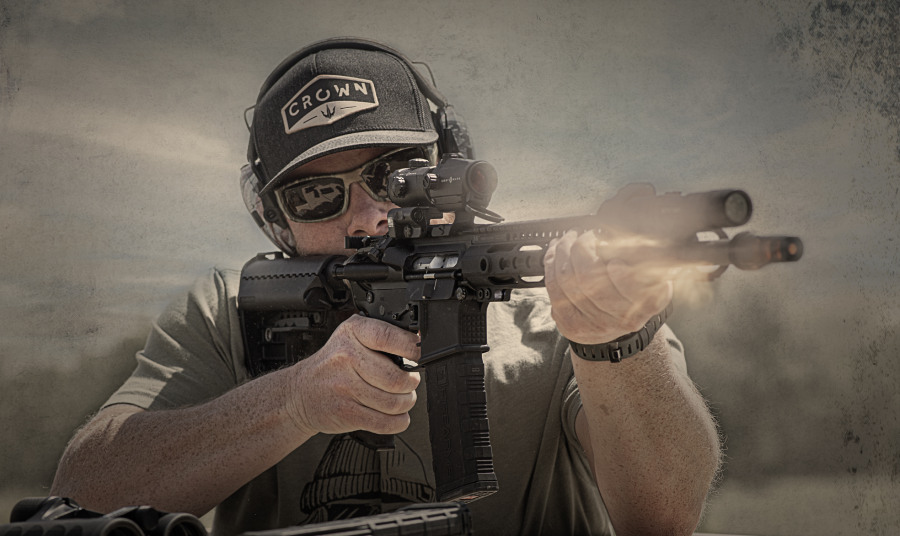When it comes to choosing between a red dot and magnifier combo versus an LPVO (Low Power Variable Optic), there's a lot to consider. Both options excel in transitioning between 1x magnification for close-quarters combat and variable magnification for medium to longer-range shooting. Each has its own set of advantages and disadvantages. After reading this article, you, the discerning firearms enthusiast, will hopefully be able to determine which optic system best suits your needs.

What Is an LPVO (Low Power Variable Optic)?
LPVOs are known for their versatility and recognizable design. They are easily identified by their slim objective lens, lack of an objective bell, and an ocular lens larger than the rest of its body. Typically, an LPVO has a base magnification of 1x and features an etched reticle, with the only electronic component being the illuminated reticle. The maximum magnification usually ranges from 4x to 10x, allowing for adaptability across various shooting scenarios.
Pros of LPVOs
- Versatility: With a range from 1x to 4x, 6x, or 10x, LPVOs cover a wide spectrum of shooting distances.
- Durability: The etched reticle and minimal electronic components make LPVOs robust and reliable, especially because they don’t rely on batteries.
- Ease of Use: A good LPVO, like the Sightmark Presidio 1-6x24 CR1, often includes a throw lever for quick magnification changes.
Cons of LPVOs
- Eye Relief Sensitivity: LPVOs require careful attention to eye position, especially at higher magnifications.
- Weight and Bulk: They can be heavier and bulkier compared to a simple red dot sight.
- Complexity: Adjusting magnification might take longer than a simple flip of a magnifier.

Red Dot and Magnifier Combos
A red dot and magnifier combo consists of two separate components: a red dot sight and a magnifier. This setup usually costs more than an LPVO but offers rapid transitions between 1x and magnified views. The red dot is a true 1x sight with a battery-powered LED reticle, while the magnifier, positioned behind the red dot, allows quick switching between 1x and its set magnification with a single motion. Sightmark’s XTM-3 is one of the most compact magnifiers on the market today. At just 3 inches long, the XTM-3 provides a 3x magnification without sacrificing too much size or weight, making it great for compact builds.
Pros of Red Dot/Magnifier Combos
- Speed: Transitioning from 1x to magnified and back is extremely fast with a simple flip or slide mechanism.
- Simplicity: The red dot provides a clear, unobstructed view, ideal for close-quarters combat.
- Modularity: You can choose different magnifiers to pair with your red dot, customizing your setup.
Cons of Red Dot/Magnifier Combos
- Battery Dependency: The red dot relies on batteries, and if they fail, so does your sighting system.
- Fixed Magnification Steps: Unlike LPVOs, you can only switch between 1x and the magnifier’s fixed magnification (e.g., 3x), but no higher or lower, limiting your magnification range.
- Potential for Bulkiness: Adding a magnifier increases the overall size and weight of the setup.
LPVO vs Magnifier: Which One Should You Choose?
Choosing between an LPVO and a red dot/magnifier combo ultimately depends on your specific needs and preferences. LPVOs offer a wider range of magnifications and are less dependent on batteries, making them versatile and reliable for varied shooting distances. However, they can be bulkier and more sensitive to eye relief.
On the other hand, red dot/magnifier combos provide unparalleled speed in transitioning between magnifications and offer a simpler, more modular setup. Their reliance on batteries and fixed magnification steps can be limiting, but they excel in close-quarters scenarios where rapid target acquisition is crucial.
Ultimately, the best choice is the one that fits your shooting style and operational requirements. Both systems have their merits, and understanding these will help you make an informed decision.
Shop Optics for Every Mission
Frequently Asked Questions
What is an LPVO (Low Power Variable Optic)?
LPVOs are optics known for their versatility, with a base magnification of 1x and the ability to adjust to magnifications ranging from 4x to 10x for various shooting scenarios.
What are the pros of LPVOs?
The pros of LPVOs include versatility in shooting distances, durability due to an etched reticle and minimal electronic components, and ease of use with features like throw levers for quick magnification changes.
What are the cons of LPVOs?
The cons of LPVOs include sensitivity to eye relief, weight and bulkiness compared to red dot sights, and potential complexity in adjusting magnification.
What are red dot and magnifier combos?
Red dot and magnifier combos consist of a red dot sight and a magnifier, allowing for rapid transitions between 1x and magnified views with a simple flip or slide mechanism.
What are the pros of red dot and magnifier combos?
The pros of red dot and magnifier combos include speed in transitioning between 1x and magnified views, simplicity in providing a clear view for close-quarters combat, and modularity in customizing your setup with different magnifiers.
What are the cons of red dot and magnifier combos?
The cons of red dot and magnifier combos include dependency on batteries for the red dot sight, fixed magnification steps with the magnifier, and potential limitations in magnification options compared to LPVOs.




